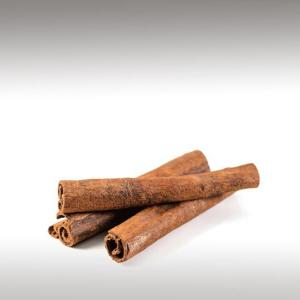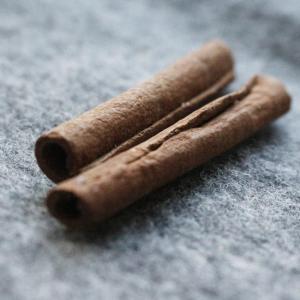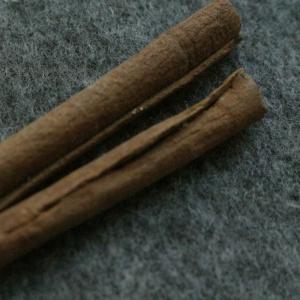
CINNAMON STICK (CINNAMOMUM VERUM) - INGREDIENTS

BASE / GENERAL DATA
Information submited: April 8, 2015 Modified: May 30, 2018 By: OperaDreamhouse
Cinnamon is a spice obtained from the inner bark of several trees from the genus Cinnamomum. Cinnamon is the name for perhaps a dozen species of trees and the commercialspice products that some of them produce. All are members of the genus Cinnamomum in the family Lauraceae. Only a few of them are grown commercially for spice.
True Cinnamon, the bark of Cinnamomum Verum (also called Cinnamomum Zeylanicum) from Sri Lanka.
Though its source was kept mysterious in the Mediterranean world for centuries by the middlemen who handled the spice trade, to protect their monopoly as suppliers, Cinnamon is native to Bangladesh, Sri Lanka, the Malabar Coast of India, and Burma.
Sri Lanka produces 80 - 90% of the world's supply of Cinnamomum Verum, but that is the only species grown there Cinnamomum. Verum is also cultivated on a commercial scale in Seychelles and Madagascar. India and Vietnam are also minor producers.
Cinnamon is cultivated by growing the tree for two years, then coppicing it, cutting the stems at ground level. The following year, about a dozen new shoots will from the roots, replacing those that were cut.
The stems must be processed immediately after harvesting while the inner bark is still wet. The cut stems are processed by scraping off the outer bark, then beating the branch evenly with a hammer to loosen the inner bark, which is then pried off in long rolls. Only 0,5 mm of the inner bark is used.
The processed bark will dry completely in four to six hours, provided it is in a well - ventilated and relatively warm environment. Once dry, thebark is cut into 5 - 10 cm lengths for sale. A less than ideal drying environment encourages the proliferation of pests in the bark, which may then require treatment by fumigation. Fumigated bark is not considered to be of the same premium quality as untreated bark.
Sri Lanka cinnamon has a very thin, smooth bark with a light-yellowish brown colour and a highly fragrant aroma. Any pieces of bark less than 106 mm long are categorized as quillings. Featherings are the inner barkof twigs and twisted shoots. Chips are trimmings of quills, outer and inner bark that cannot be separated, or thebark of small twigs.
Cinnamomum Verum is sometimes considered to be "True Cinnamon", most Cinnamon in international commerce is derived from related species, which are also referred to as "Cassia" to distinguish them from "True Cinnamon". The name of Cassia, first recorded in English around 1000 AD, was borrowed via Latin and ultimately derives from Hebrew, a form of the verb "Strip off Bark".
Cassia, the bark of Cinnamomum iners from Arabia and Ethiopia, literally "The Peel of the Plant" which is scraped off the tree.
The English word Cinnamon, attested in English since the 15th century, derives from the Greek Kinnámōmon, via Latin and medieval French intermediate forms. The Greek in turn was borrowed from a Phoenician word, which would have been akin to the related Hebrew Qinnamon.
Cinnamon has been known from remote antiquity. It was imported to Egypt as early as 2000 BC, but those who report it had come from China confuse it with Cassia. Cinnamon was so highly prized among ancient nations that it was regarded as a gift fit for monarchs and even for a god.
According to Pliny, a Roman pound of Cinnamon, or serichatum cost up to 300 denarii, the wage of ten months labour. Cinnamon was too expensive to be commonly used on funeral pyres in Rome, but the Emperor Nero is said to have burned a year's worth of the city's supply at the funeral for his wife Poppaea Sabina in AD 65.
The first Greek reference to Casia is found in a poem by Sappho in the seventh century BC. According to Herodotus, both Cinnamon and Cassia grew in Arabia, together with incense, Myrrh, and Ladanum, and were guarded by winged serpents. The Phoenix was reputed to build its nest from Cinnamon and Cassia. Herodotus mentions other writers who believed the source of Cassia was the home of Dionysos, located somewhere east or south of Greece.
True Cinnamon, the bark of Cinnamomum Verum (also called Cinnamomum Zeylanicum) from Sri Lanka.
Though its source was kept mysterious in the Mediterranean world for centuries by the middlemen who handled the spice trade, to protect their monopoly as suppliers, Cinnamon is native to Bangladesh, Sri Lanka, the Malabar Coast of India, and Burma.
Sri Lanka produces 80 - 90% of the world's supply of Cinnamomum Verum, but that is the only species grown there Cinnamomum. Verum is also cultivated on a commercial scale in Seychelles and Madagascar. India and Vietnam are also minor producers.
Cinnamon is cultivated by growing the tree for two years, then coppicing it, cutting the stems at ground level. The following year, about a dozen new shoots will from the roots, replacing those that were cut.
The stems must be processed immediately after harvesting while the inner bark is still wet. The cut stems are processed by scraping off the outer bark, then beating the branch evenly with a hammer to loosen the inner bark, which is then pried off in long rolls. Only 0,5 mm of the inner bark is used.
The processed bark will dry completely in four to six hours, provided it is in a well - ventilated and relatively warm environment. Once dry, thebark is cut into 5 - 10 cm lengths for sale. A less than ideal drying environment encourages the proliferation of pests in the bark, which may then require treatment by fumigation. Fumigated bark is not considered to be of the same premium quality as untreated bark.
Sri Lanka cinnamon has a very thin, smooth bark with a light-yellowish brown colour and a highly fragrant aroma. Any pieces of bark less than 106 mm long are categorized as quillings. Featherings are the inner barkof twigs and twisted shoots. Chips are trimmings of quills, outer and inner bark that cannot be separated, or thebark of small twigs.
Cinnamomum Verum is sometimes considered to be "True Cinnamon", most Cinnamon in international commerce is derived from related species, which are also referred to as "Cassia" to distinguish them from "True Cinnamon". The name of Cassia, first recorded in English around 1000 AD, was borrowed via Latin and ultimately derives from Hebrew, a form of the verb "Strip off Bark".
Cassia, the bark of Cinnamomum iners from Arabia and Ethiopia, literally "The Peel of the Plant" which is scraped off the tree.
The English word Cinnamon, attested in English since the 15th century, derives from the Greek Kinnámōmon, via Latin and medieval French intermediate forms. The Greek in turn was borrowed from a Phoenician word, which would have been akin to the related Hebrew Qinnamon.
Cinnamon has been known from remote antiquity. It was imported to Egypt as early as 2000 BC, but those who report it had come from China confuse it with Cassia. Cinnamon was so highly prized among ancient nations that it was regarded as a gift fit for monarchs and even for a god.
According to Pliny, a Roman pound of Cinnamon, or serichatum cost up to 300 denarii, the wage of ten months labour. Cinnamon was too expensive to be commonly used on funeral pyres in Rome, but the Emperor Nero is said to have burned a year's worth of the city's supply at the funeral for his wife Poppaea Sabina in AD 65.
The first Greek reference to Casia is found in a poem by Sappho in the seventh century BC. According to Herodotus, both Cinnamon and Cassia grew in Arabia, together with incense, Myrrh, and Ladanum, and were guarded by winged serpents. The Phoenix was reputed to build its nest from Cinnamon and Cassia. Herodotus mentions other writers who believed the source of Cassia was the home of Dionysos, located somewhere east or south of Greece.
Chemical structure:
Sweet Cinnamon can contain up to 4% oil of cinnamaldehyde, eugenol, and trans-cinnamic acid, however it is usually lighter in oil content and sweeter tasting than Cassia Cinnamon.
It also contains phenolic compounds, tannins, catechins, calcium, iron, mucilage, resin, natural sugars, and traces of coumarin.

SPIRITUAL PRACTISES DATA
Information submited: April 8, 2015 By: OperaDreamhouse
Egyptian recipes for kyphi, an aromatic used for burning, included cinnamon and cassia from Hellenistic times onward. The gifts of Hellenistic rulers to temples sometimes included cassia and cinnamon as well as incense, myrrh, and Indian incense (kostos), so one might conclude that the Greeks used it for similar purposes.
Cassia was also part of the ketoret, the consecrated incense described in the Hebrew Bible and Talmud. It was offered on the specialized incense altar in the time when the Tabernacle was located in the First and Second Jerusalem temples. The ketoret was an important component of the temple service in Jerusalem.
Cassia was also part of the ketoret, the consecrated incense described in the Hebrew Bible and Talmud. It was offered on the specialized incense altar in the time when the Tabernacle was located in the First and Second Jerusalem temples. The ketoret was an important component of the temple service in Jerusalem.

MEDICINE / HEALTH DATA
Information submited: April 8, 2015 Modified: May 30, 2018 By: OperaDreamhouse
Cinnamon has a long history of use in traditional medicine. Ancient folklore says the smell of Cinnamon is the best cure for the winter blues.
Cinnamon can be the solution for blood sugar control, weight loss, alertness, creating natural disinfectants, cancer prevention.
Several studies have found that Cinnamon has properties that help those withinsulin resistance. It is therefore very popular withType IIdiabetics who take it to control theirblood sugar variations.
Cinnamon can be the solution for blood sugar control, weight loss, alertness, creating natural disinfectants, cancer prevention.
Several studies have found that Cinnamon has properties that help those withinsulin resistance. It is therefore very popular withType IIdiabetics who take it to control theirblood sugar variations.
Cinnamon has a 3 - 5% effect onblood sugar levels, similar to an older generation of diabetes drugs. That could make it an ideal option for pre diabetics.
Cinnamon is a powerfulanti-bacterial. Research has shown Cinnamon is one of the most effective substances against escherichia coli, salmonella, campylobacter.
Research shows that Cinnamon oil is a promising solution in the treatment of tumors, gastric cancersand melanomas. Research studies show that sugar maybe causing or sustaining cancer cells and Cinnamon may have a mitigating effect by controllingblood sugar levels in the body.
Another study found good results with leukemia and lymphoma cancer cells. Cinnamon in its various forms has two chemical constituents called cinnamaldehyde and eugenol (From Cinnamon oil). These have been used to develop nutraceuticals in this study that have proven fairly effective in fighting human coloncancer cells (Eugenol) and human hepatoma cells (Cinnamaldehyde).
Most of the evidence that Cinnamon helpsarthritis is from personal testimonials. Some people claim drinking Cinnamon tea helps the pain from arthritiswhile others claim a Cinnamon oil based massage oil helps ease the pain.
Cinnamon has high levels ( in two sticks of Cinnamon) ofmanganese which is used tobuild bones,blood and other connective tissues. The body needs manganese for optimal bone health, so people who are deficient in the mineral are more likely to develop osteoporosis.
German study cited in this article those taking cinnamon improved their response times and memory recall. While not scientific, our personal experience suggests pretty good results in alertness and concentration.
Cinnamon is one of the top seven anti-oxidants in the world. The suggestion is thatanti-oxidants reduce the formation of "free radicals" that cause cancer. This study found Cinnamon has sufficient anti-oxidant properties and makes for improved food palatability.
Cinnamon's powerful anti fungal properties are the perfect natural alternative to killing the athletes foot fungus. You can use Cinnamon Sticks or even better a few drops of powerful Ceylon Cinnamon Leaf oil.
Cinnamonum is one of the most effective E-coli fighters because of its antimicrobial properties.The anti-bacterial properties of Cinnamon play a crucial role in getting rid of harmful bacteria without damaging yourteeth or gums. It's one of the reasons that cinnamon oil is often used in chewing gums,mouthwashes, toothpaste and breath mints.
One teaspoon of Cinnamon Powder has 0,33mg (16% DV) Manganese, 0,76 mg (4% DV) Iron, 24,56 mg (2% DV) Calcium. Manganese apparently works as an enzyme activator and plays an important role in building good structure andbone metabolism.
Because of the high levels of manganese Cinnamon may be an excellent candidate to mitigate the effects ofPMS. These results suggest that a manganese rich diet may helpreduce symptoms of PMS. Another clinical study found that 46 patients withPMS had significantly lower amounts of calcium, chromium, copper, and manganese in their blood. You should not consume more than 11 mg of Manganese per day (about 12 Cinnamon Sticks) according NYU.
How much cinnamon should you take?
Because Cinnamon is an unproven treatment, there is no established dose. Some recommend 1/2 to 1 teaspoon (2 - 4 grams) of powder a day. Some studies have used between 1 gram and 6 grams of Cinnamon. Very high doses may be toxic.
Side effects:
Heavy use of Cinnamon may irritate the mouth and lips, causing sores. In some people, it can cause anallergic reaction. Applied to the skin, it might cause redness and irritation.
Very high quantities of Cinnamon may be toxic, particularly in people withliver problems. Because Cinnamon may lower blood sugar, people with diabetes may need to adjust their treatment if they use Cinnamon supplements.
An ingredient in some Cinnamon products, coumarin, maycause liver problems. Given the lack of evidence about its safety, Cinnamon as a treatment is not recommended for children or for women who are pregnant or breastfeeding.
Cinnamon is a powerfulanti-bacterial. Research has shown Cinnamon is one of the most effective substances against escherichia coli, salmonella, campylobacter.
Research shows that Cinnamon oil is a promising solution in the treatment of tumors, gastric cancersand melanomas. Research studies show that sugar maybe causing or sustaining cancer cells and Cinnamon may have a mitigating effect by controllingblood sugar levels in the body.
Another study found good results with leukemia and lymphoma cancer cells. Cinnamon in its various forms has two chemical constituents called cinnamaldehyde and eugenol (From Cinnamon oil). These have been used to develop nutraceuticals in this study that have proven fairly effective in fighting human coloncancer cells (Eugenol) and human hepatoma cells (Cinnamaldehyde).
Most of the evidence that Cinnamon helpsarthritis is from personal testimonials. Some people claim drinking Cinnamon tea helps the pain from arthritiswhile others claim a Cinnamon oil based massage oil helps ease the pain.
Cinnamon has high levels ( in two sticks of Cinnamon) ofmanganese which is used tobuild bones,blood and other connective tissues. The body needs manganese for optimal bone health, so people who are deficient in the mineral are more likely to develop osteoporosis.
German study cited in this article those taking cinnamon improved their response times and memory recall. While not scientific, our personal experience suggests pretty good results in alertness and concentration.
Cinnamon is one of the top seven anti-oxidants in the world. The suggestion is thatanti-oxidants reduce the formation of "free radicals" that cause cancer. This study found Cinnamon has sufficient anti-oxidant properties and makes for improved food palatability.
Cinnamon's powerful anti fungal properties are the perfect natural alternative to killing the athletes foot fungus. You can use Cinnamon Sticks or even better a few drops of powerful Ceylon Cinnamon Leaf oil.
Cinnamonum is one of the most effective E-coli fighters because of its antimicrobial properties.The anti-bacterial properties of Cinnamon play a crucial role in getting rid of harmful bacteria without damaging yourteeth or gums. It's one of the reasons that cinnamon oil is often used in chewing gums,mouthwashes, toothpaste and breath mints.
One teaspoon of Cinnamon Powder has 0,33mg (16% DV) Manganese, 0,76 mg (4% DV) Iron, 24,56 mg (2% DV) Calcium. Manganese apparently works as an enzyme activator and plays an important role in building good structure andbone metabolism.
Because of the high levels of manganese Cinnamon may be an excellent candidate to mitigate the effects ofPMS. These results suggest that a manganese rich diet may helpreduce symptoms of PMS. Another clinical study found that 46 patients withPMS had significantly lower amounts of calcium, chromium, copper, and manganese in their blood. You should not consume more than 11 mg of Manganese per day (about 12 Cinnamon Sticks) according NYU.
How much cinnamon should you take?
Because Cinnamon is an unproven treatment, there is no established dose. Some recommend 1/2 to 1 teaspoon (2 - 4 grams) of powder a day. Some studies have used between 1 gram and 6 grams of Cinnamon. Very high doses may be toxic.
Side effects:
Heavy use of Cinnamon may irritate the mouth and lips, causing sores. In some people, it can cause anallergic reaction. Applied to the skin, it might cause redness and irritation.
Very high quantities of Cinnamon may be toxic, particularly in people withliver problems. Because Cinnamon may lower blood sugar, people with diabetes may need to adjust their treatment if they use Cinnamon supplements.
An ingredient in some Cinnamon products, coumarin, maycause liver problems. Given the lack of evidence about its safety, Cinnamon as a treatment is not recommended for children or for women who are pregnant or breastfeeding.

BEAUTY / COSMETICS DATA

FOOD / COOKING DATA
Information submited: April 8, 2015 Modified: May 30, 2018 By: OperaDreamhouse
Thebarks, when whole, are easily distinguished, and their microscopic characteristics are also quite distinct. Ceylon Cinnamon Sticks have many thin layers and can easily be made into powder using a coffee or spice grinder, whereas Cassia Sticks are much harder.
Cinnamon powder has long been an important spice in enhancing the flavor of Persian cuisine, used in a variety of thick soups, drinks, and sweets.
Cinnamon bark is widely used as aspice. It is principally employed in cookery as a condiment and flavouring material. It is used in the preparation of chocolate, especially in Mexico, which is the main importer of Cinnamon. It is also used in many dessert recipes, such asapple pie, doughnuts, and Cinnamon buns as well as spicy candies, coffee, tea, hot Cocoa.
In the Middle East, Cinnamon is often used in savoury dishes ofchicken and lamb.
It is also used in Turkish cuisine for both sweet and savoury dishes.
Besides use as flavourant and spice in foods, Cinnamon flavoured tea, also flavoured with Cardamom, is consumed as a hot beverage in Bangladesh, India and Pakistan.
The Greeks used Casia or malabathron to flavour wine, together with absinth Wormwood (Artemisia Absinthium).
During the middle ages it was used as a meat preservative due to its anti-bacterial and anti-fungal qualities, but also so that it could mask the stench of “aged” meats much better than Salt.
Cinnamon is effective in inhibiting bacterial growth. This maybe one reason why it is widely used in food preparation in hot Asian countries. In Sri Lanka, virtually every dish has a pinch of Cinnamon in it. In addition to great flavor, Cinnamon in combination with other spices like Turmeric and Chili may have been an indigenous solution to preserve food without a refrigerator.
Cinnamon powder has long been an important spice in enhancing the flavor of Persian cuisine, used in a variety of thick soups, drinks, and sweets.
Cinnamon bark is widely used as aspice. It is principally employed in cookery as a condiment and flavouring material. It is used in the preparation of chocolate, especially in Mexico, which is the main importer of Cinnamon. It is also used in many dessert recipes, such asapple pie, doughnuts, and Cinnamon buns as well as spicy candies, coffee, tea, hot Cocoa.
In the Middle East, Cinnamon is often used in savoury dishes ofchicken and lamb.
It is also used in Turkish cuisine for both sweet and savoury dishes.
Besides use as flavourant and spice in foods, Cinnamon flavoured tea, also flavoured with Cardamom, is consumed as a hot beverage in Bangladesh, India and Pakistan.
The Greeks used Casia or malabathron to flavour wine, together with absinth Wormwood (Artemisia Absinthium).
During the middle ages it was used as a meat preservative due to its anti-bacterial and anti-fungal qualities, but also so that it could mask the stench of “aged” meats much better than Salt.
Cinnamon is effective in inhibiting bacterial growth. This maybe one reason why it is widely used in food preparation in hot Asian countries. In Sri Lanka, virtually every dish has a pinch of Cinnamon in it. In addition to great flavor, Cinnamon in combination with other spices like Turmeric and Chili may have been an indigenous solution to preserve food without a refrigerator.
COMMENTS
No comments.
Newest mixtures containing Cinnamon Stick (Cinnamomum Verum):

Daily metabolism-boosting immune drink
May 19, 2015




